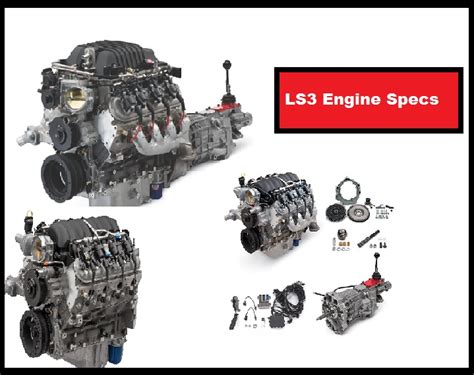Explore LS3 engine specifications, learn how to optimize air and fuel delivery, and discover advanced ignition timing techniques for enhanced performance.The LS3 engine, renowned for its impressive performance and versatility, is a favorite among automotive enthusiasts and builders alike. Whether you’re a DIY car hobbyist or a seasoned performance tuner, understanding the intricacies of the LS3 is crucial for maximizing its potential. In this blog post, we’ll delve into effective tuning techniques that can help you unleash the full power of your LS3 engine. We’ll start by exploring the engine’s specifications to give you a solid foundation, then move on to optimizing air and fuel delivery for improved efficiency and horsepower. Finally, we’ll tackle advanced ignition timing strategies to fine-tune performance further. Gear up as we embark on this journey to unlock the true capabilities of your LS3!
Understanding LS3 Engine Specifications

The LS3 engine, a member of the highly regarded LS engine family, is known for its performance and efficiency. It is a small-block V8 engine characterized by a variety of specifications that make it a popular choice among enthusiasts and tuners.
The LS3 engine was first introduced in the Chevrolet Corvette and later used in the Camaro and other GM performance vehicles. Below is a table outlining some of its key specifications:
| Specification | Value |
|---|---|
| Displacement | 6.2 liters |
| Horsepower | 430 hp |
| Torque | 426 lb-ft |
| Compression Ratio | 10.7:1 |
| Fuel System | Direct injection |
| Block Material | Aluminum |
The LS3’s architecture enables it to deliver impressive torque and horsepower figures, making it suitable not only for daily driving but also for high-performance applications. In addition to its basic specifications, it’s important to note the various features that aid in enhancing its performance.
Equipped with features like aluminum cylinder heads and a *high-flow intake manifold*, the LS3 is designed to maximize airflow, which is critical for performance tuning. Understanding these specifications is crucial in optimizing the air-fuel mixture and overall engine performance.
Optimizing Air and Fuel Delivery

Optimizing air and fuel delivery is crucial for enhancing the overall performance of your LS3 engine. The balance of these two components directly affects the efficiency and power output of the engine. By fine-tuning air intake and fuel mixture, you can achieve impressive gains in horsepower and torque.
One effective way to optimize air delivery is by upgrading to a high-performance cold air intake system. This system helps to increase the volume of cold air entering the engine, which is denser and contains more oxygen than warm air. The result is a more efficient combustion process. Furthermore, it’s important to consider the throttle body. Installing a larger diameter throttle body allows for increased airflow, which can significantly improve acceleration and throttle response.
In terms of fuel delivery, fuel injectors play a pivotal role. Upgrading to higher flow-rate fuel injectors ensures that the engine receives an adequate amount of fuel to match the increased air volume. Additionally, tuning the fuel pressure regulator to maintain optimal fuel pressure during various RPM levels is essential. Utilizing engine management software can help you monitor and adjust the air-fuel ratio for the best performance.
Utilizing Advanced Ignition Timing

When it comes to tuning LS3 engines, one of the most crucial aspects to optimize is the ignition timing. Properly managing ignition timing can significantly enhance engine performance, increase torque, and improve fuel efficiency. LS3 engines, renowned for their robust power delivery, can benefit from advanced tuning techniques to adjust the timing curves for better performance.
The goal of advanced ignition timing is to ensure that the spark plug ignites the air-fuel mixture at the optimal moment. Too early or too late an ignition can lead to knocking or inefficient combustion, which can adversely affect performance. Ideally, the timing should be set to allow complete combustion before the piston reaches the top dead center (TDC).
To effectively utilize advanced ignition timing, tuners often adjust the timing maps within the ECU, which control when the ignition occurs during the engine’s cycle. Tools such as a wideband O2 sensor and a dyno are invaluable for fine-tuning this parameter to find the optimal balanc
Frequently Asked Questions

What are LS3 engines?
LS3 engines are high-performance V8 engines from General Motors, known for their crankshaft and aluminum block, widely used in various GM vehicles.
What is the goal of tuning an LS3 engine?
The goal of tuning an LS3 engine is to optimize its performance by adjusting parameters like fuel mixture, ignition timing, and throttle response to achieve better power output and efficiency.
What tools are essential for tuning an LS3 engine?
Essential tools include a good quality tuning software, an OBD2 scanner, a dyno for performance testing, and a wideband O2 sensor for monitoring air-fuel ratios.
What are some common tuning techniques for LS3 engines?
Common tuning techniques include recalibrating the ECU, adjusting fuel tables, modifying ignition timing maps, and optimizing air intake and exhaust systems.
How can exhaust upgrades affect LS3 engine tuning?
Exhaust upgrades can improve airflow, reducing back pressure and allowing for better engine breathing, which can significantly enhance performance if tuned properly.
What role does a cold air intake play in LS3 tuning?
A cold air intake increases airflow into the engine, improving combustion efficiency and power output, making it a popular modification in LS3 engine tuning.
Why is professional tuning recommended for LS3 engines?
Professional tuning is recommended because it ensures that all adjustments are precisely calibrated, maximizing performance while maintaining engine reliability and avoiding potential damage.